Visiting Aotearoa for all the right reasons
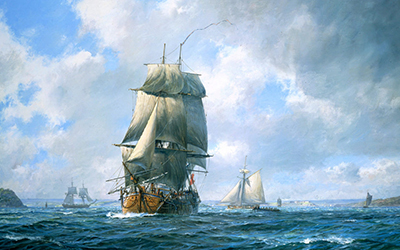
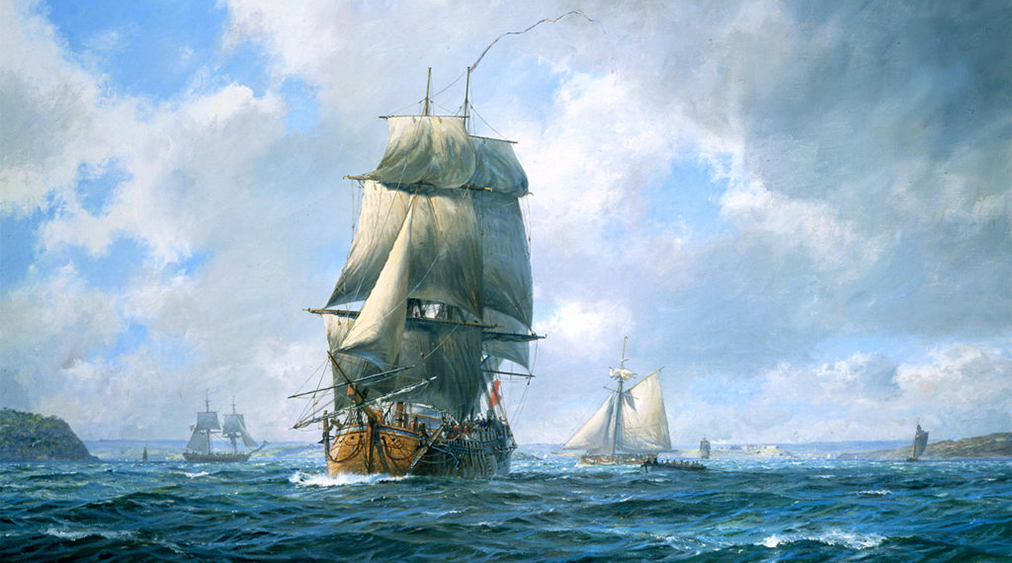
Continent There All Along: The unique last-and-first stories that Aotearoa has to tell the world, perfectly positions it to deliver spell-binding tales of civilisation’s existential struggle-of-its-own-making, and own salvation. And it begins with the still unfolding story of how geologists discovered the continent that Captain James Cook was dispatched to find and wasn’t there, but in fact was—Zealandia. Meanwhile, if a 20-hour ferry trip sounds longish—see below—spare a thought for the crew of the hms Endeavour, during her 20-day Tasman Sea crossing. artist Geoff Hunt | Diploma Collection of the Royal Society of Marine Artists
Neither of New Zealand’s two main industries is currently sustainable. Its once-vaunted agricultural industry, a proud part of the green revolution, is now a climate delinquent, due to the white gold-rush.
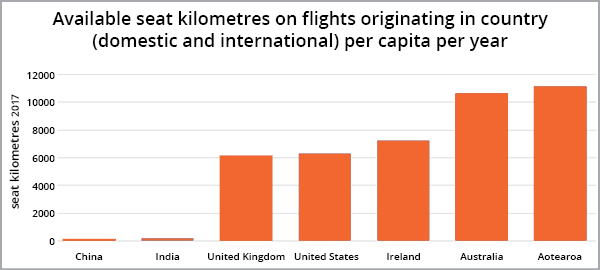
Punching Above Aus. Weight: On air travel alone, Aotearoa is contributing to more than its share of climate havoc. While trips-per-capita the Irish fly more often, they fly less than New Zealanders—mind, the figures above include visitors, departing. New Zealand’s readily achievable goal is to have its tourists to do more, more actively, for longer, zero-carbon. Having them arrive and depart zero-carbon will require bold, outside-the-box action. chart Mahurangi Magazine | data The World Bank
Tourism, which continues to outdistance dairy as the country’s largest export earner, is part of the burgeoning climate disaster that is discretionary long-haul air travel. And while freedom camping is caned for its unsavoury side effects, not a corporate-mainstream-media moment of disquiet is evoked by its substantive environmental impact, on climate. Carting around tonnes of steel and plastic in the form of motorhomes29,582 registered in 2017. Stuff. Potentially a total of 150,000 tonnes?, large or small, is an inherently wasteful tourism model—the polar-melting extreme opposite of what zero-carbon tourism should look like.
Given the glacial pace of climate action mobilisation, the impacts of anthropogenic global warming are now destined to impact humanity for centuries. Strategically, it’s in New Zealand’s best interests to front-foot the hundred years’ climate war by rapidly becoming a global, democratic-climate-action role model. Climate-action tourism would be a great place to start. Even without the dots being joined to climate action, New Zealand tourism has recently been reinvented, largely by rail trails, which, in turn, are receiving a further boost from that rare, environmentally sound use of battery-stored electricity for transportationOf the nearly 900 all-electric buses purchased within the United States, only 207 are actually in service. San Francisco Municipal Transportation Agency, May 2018. http://www.greencarcongress.com/2018/05/20180516-muni.html: e-bikes. While this is all entirely edifying, the heroic leap now required is into rail-with-trail, between Invercargill and Kaikohe, an electrified, 2000 kilometres all the way.
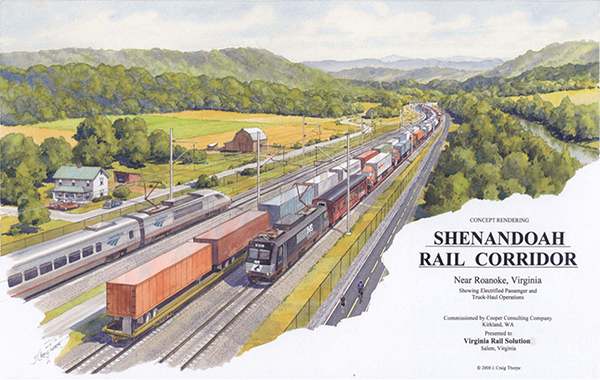
Oh Shenandoah: Up against a heartless, small-government mindset, the Virginia Bicycling Federation’s call for a modicum of the federal and state budget for rail—$3.2 billion in 2011—to be used building rail-with-trail appears to have gone unheeded, at least in respect to this vision. While New Zealanders were early adopters of neoliberal notions, nor are they inherently mean-minded, plus they readily see themselves as world leaders, making this rendering ripe for recycling by a more innovative community. concept rendering Craig Thorpe
The element that’s currently lacking, in the climate-action call to arms, is that which was abundantly on offer when volunteers were called for at the outbreak of great wars—the lust for action:
Women too. In the United Kingdom, by the time World War II broke out, the Women’s Voluntary Services for Air Raid Precautions already had 165 000 members.
Building the infrastructure for a zero-carbon country—of which the 2000-kilometre rail-with-trail will only be a tiny part, albeit the hero element—will take careful planning and even more careful construction. But building essential zero-carbon infrastructure would potentially provide living-wage work for the 338 000 New Zealanders currently underutilised or unemployed. The current preoccupation with the future of work reflects a frightening failure to apprehend the magnitude of the task of rebuilding post-carbon civilisation. Robotics will increasingly be deployed, but nor will they be cause to continue the relegation of an increasing proportion of the population as superfluous. That travesty, was solely the prerogative of the rich-get-richer doctrine of the market, and a poorly perceived one at that—unless the actual, unacknowledged, objective was other-than-to maximise profits, and was to gratuitously create losers.
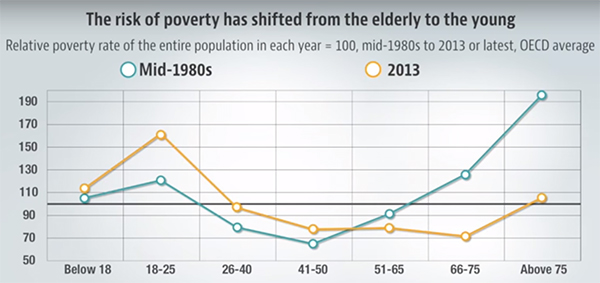
Neoliberal Trashing of Youth: The chronic reliance on neoliberalism, with its distain for government planning, has left civilisation flat-footed in the face of its first actual existential crisis—and young people left unfit and unwanted at the very time every last one of them is needed in the fight to salvage a survivable climate. Meanwhile, New Zealand’s incarceration rate is the highest for a full democracy—the antipathy of productivity. chart Organisation for Economic Co-operation and Development
The mistake make-work schemes made was to focus on reducing unemployment, no matter how menial or meaningless. But nor should the think-big cost-plus rort of the 1960s be repeated. Ultimately, there is no substitute for good, as opposed to greedy, management. The self-serving, pay-peanuts fallacy that massive managerial salaries must be paid, needs to be the first monkey to be taken off the back of public good, climate action projects. Ultimately, job satisfaction is the more effective rewarder of sky-high performance than six- and seven-figure salaries, and 24-karat golden parachutes. Besides, globally, a modest five-figure salary—US$32 400—is sufficient to put a person in the top 1%.
The necessity to also export democracy is driven by the fact that the current bought-and-paid-for form of it has long since proved to be unfit for addressing the long-term needs of its citizens. Alone, the overrepresentation of Māori incarcerated—seven times higher than the balance of the population—should be sufficiently sobering to expedite a nonpartisan approach to penal reform. Instead, the New Zealand National Party is orchestrating a public-opinion lynch mob to perpetuate the state-funding of the crime academies so accomplished at turning minor offenders into hardened gang members. Excluding that unredeemable outlier, the United States645,300 more incarcerated than the 4.3 times more populous China, which itself has an elevated incarceration rate, on par with New Zealand’s., only three oecd countries—none of which is a full democracy—incarcerate a higher percentage of their populations, and of the full democracies, New Zealand’s rate is nearly a third higher than that of its closest rival-in-incarceration, Australia. National knows this full well yet is so desperate to regain power that it will say anything to reclaim the disinformed and reactionary of its constituency that defected to New Zealand First, giving it the whip hand.
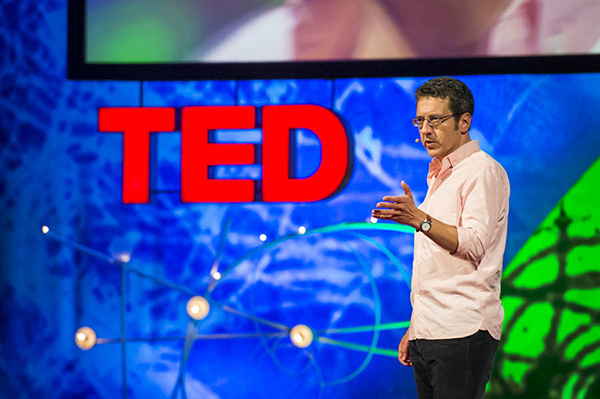
Not That Feral About Flying: Lest the wrong impression be given, no air miles were harmed in the making of George Monbiot’s 2013 ted talk, on his vision for rewilding, which Aotearoa arguably needs more desperately than the United Kingdom. Monbiot has long since forsworn air travel, nor is there excuse for much of it when, in this example, a train ride to Edinburgh and fibre-optic cable can deliver a tedGlobal talk—globally. In his latest book, Out of the Wreckage, he surgically zeroes in on campaign finance reform, as the essential first target for big organising. photographer James Duncan Davidson
The demand for decisive climate action is the severest test to which democracy has yet been put. Annually, nine million premature deaths are caused by pollution, most of those are caused by air pollution, most of which is caused by fossil-fuel combustion. The World Health Organization estimates that more than 88% of the burden of global warming is borne by children under five, yet that cohort constitutes only 10% of global population. Democracy is demonstrably broken, and comprehensively outflanked by globalism. And while fixing it will be demanding, there is some tantalisingly low-hanging fruit, the ripest of which is the radical reform of campaign finance. George Monbiot’s brutally simple proposal for campaign finance reform also addresses another broken aspect, of the party system, whereby powerful parties no longer need mass membership, so long as they have massive big-business backing. At today’s rates of membership, political parties—themselves, typically, far from democratic—are no longer even remotely representative.
Notwithstanding Monbiot’s newfound enthusiasm for the single transferable vote, Aotearoa has owned the Mercedes-Benz s-class of proportional voting systems since 1996, and it puts stv squarely in the Kombi category, but nor does it begin to democratise government by coalition. Ironically, stv, symbiotically layered upon mmp, plays a significant part in that. But by itself, stv is only fit, but is also currently the best fituntil parties become honest about their involvement in it, for local government. To repeat a Mahurangi Magazine mantra, it is in New Zealand’s self-interest to become the climate action role model. And not because it is the smartest economic strategy—although that is not a bad thing—but because it is the smartest strategy for demonstrating to the rest of the world that meaningful climate action can be taken now, vastly improving the odds for salvaging said survivable climate. And without that, New Zealanders will not escape the global misery, nor will many of their Pasifika whānau survive sea-level rise, without relocation to the main motuisland, or, as in this case, islands, the phlegmatic North Island and South Island, or more colourfully, Te Ika a Maui and Te Wai Pounamu, respectively.
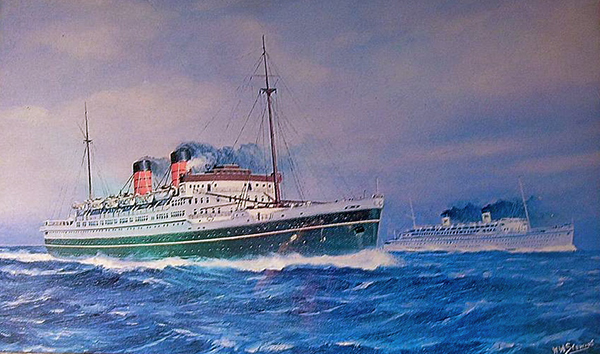
Climate-Action Legacy: Launched when the greatest threat facing civilisation was Nazi Germany, and losing her life in that fight, scientific awareness of the accumulating hazard of the fossil fuel burned by the tss Awatea and rival ss Mariposa she is depicted here overhauling, and powered pretty much everything else that moved or didn’t, was still two years away. A noble tribute to the brave Awatea would be as the namesake of a zero-carbon, climate-action troop carrier, not to mention the ‘broad daylight’ meaning of her name. And if Ports of Auckland was to build a $2.5 billion port at Puhinui, and if an upscaled* version of the ferry named for Pope Francis, she could complete the return trip in 48 hours. *Upscaled, because the Tasman is not the Río de la Plata, although the latter has recorded ~5-metre seas. artist William Walter Stewart
By unequivocally committing to become the global climate action role model, a premium would accrue to all New Zealand’s climate-savvy and climate-action exports, not least of all its tourism. Passenger services charges would be set at a level at least as realistic as the United Kingdom’s £194 duty on long-haul flights, buying visitors free access to the aforementioned 2000-kilometre rail-with-trail, the 3000-kilometre Te Araroa national walkway, a potential 15 000-kilometre coastal walkway 3⅓ times longer than England’s Coast Path, and more than 6 000 000 hectaressome of which, admittedly, is sensitive and not open to visitors of national, regional other parks and reserves.
But even with a hefty departure duty and zero-carbon transport within Aotearoa, visitors need to be able to arrive genuinely zero-carbon. Voluntary or compulsory carbon offsetting might assuage the conscience, but the carbon is still there, in the atmosphere, effectively forever. Australia is New Zealand’s main source of visitors—39%. If flying was avoided, many of those nearly 1.5 million people could travel from their homes to Aotearoa completely carbon free—provided, of course, Australia radically addresses its egregious, nearly 90% fossil-fuelled electricity generation88.1%, 1 July 2014–30 June 2015. http://aglblog.com.au/2016/03/australian-electricity-generation-fuel-mix/. The last new trans-Tasman Sea passenger liner was launched 82 years ago:
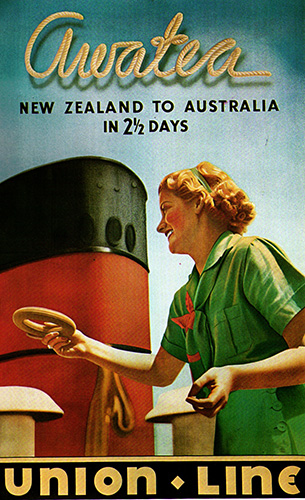
Quoits Interruptus: A latter-day Awatea travelling at 60 knots would rule out outdoor quoits, but would provide infinitely more comfortable economy-class seating than can be provided in aircraft, which, additionally, are being increasingly impacted by global-warming-caused clear-air turbulence. Descending from a mile high, and while it is hard to argue against all-of-the-above climate action, the disruption that will provide the strongest prospects for a survivable climate is a voluntary population moratorium. image Ngā Taonga Sound & Vision
The posters actually promised two and a half days. Today’s wave-piercing ferries could cross the Tasman Sea in less than half that time, however, without nuclear propulsion there would be limited climate benefit over air travel. Aside from the 120 no-expense-spared nuclear-propelled military vessels in service, there are seven Arctic ships in operation—one freighter; the balance icebreakers, with more planned. Meanwhile, faster than expected progress with small-modular-reactor development means that zero-carbon power plants will rapidly become attractive for merchant marine propulsion, at least in those parts of the world where an irrational fear of radiation doesn’t preclude it. Generations in the future will marvel that people who routinely and appreciatively availed themselves of x-rays were willing to veto a crucial zero-carbon power source, preferring to precipitate the onset of an unsurvivable climate. Better dead than red nuclear-powered. Aotearoa, having milked its nuclear-free credentials for 34 years, owes it to the planet’s mokopunagrandchildren, grandchild; child or grandchild of a son, daughter, nephew, niece… to admit that lumping nuclear propulsion in with its opposition to weapons testing was a towering triumph of ideology over intellect.
Just as Japan’s economic miracle wasn’t down to some fanciful invisible hand of the market, nor was the growth that was unlocked when investment credit funding was independently invented by Franklin Delano Roosevelt. Aotearoa will become a thriving democratic-climate-action role model only through climate-action quantitative easing, deliberate planning, and deliberative planning at that—the transformation needs to be owned by the populace. Policy cannot continue to be something that is done to the people, and become something done by, and owned by, the people. Policy gains, otherwise, can be quickly undone by less visionary successors—in Franklin D Roosevelt’s case, by the highly ranked, but nevertheless, four-places-lower ranked, Harry S Truman. In 1992, New Zealanders votedalbeit with a turnout of only 55% by 85% to dismantle its two-party duopoly, and selected the mixed-member-proportional option. But rather than accept the spirit of the historic decision, political parties continued to treat, and continue to treat, the new landscape as the old battlefield, forming any expedient alliance with the potential to gain the whip hand. Few New Zealanders appreciate that it is astonishingly rare for an electoral system to change in response to pressure by the people, as opposed to the political élite. Having done it once, it can be done again, and again, in the robust tradition of kaizen—constant improvement. Integral to the Japanese economic miracle, constant-improvement originated in the United States to meet the time-critical manufacturing challenges of World War II. Only through constant improvement will it be ensured that democracy never again slips through humanity’s fingers to leave it in mortal peril.
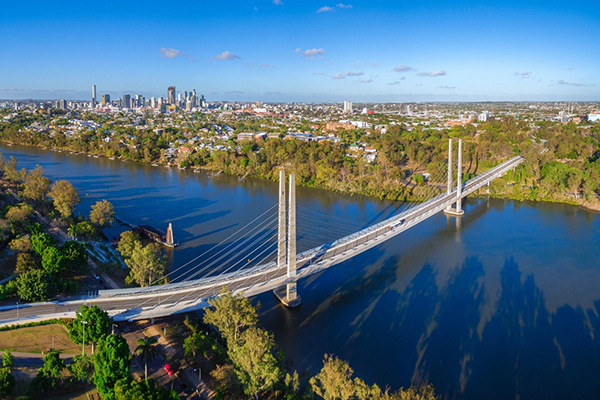
Look No Cars: Protected from peak-car on three sides by the Brisbane River, the active-transport Eleanor Schonell Bridge, since it opened in 2006, has slashed the car share of transport to the University of Queensland from 59% to 38%, 2002 to 2017. A second car-free bridge is in the planning, incidentally invoking outrage from affected leafy boroughs, reminiscent of the opposition to Auckland’s SkyPath. Given Brisbane’s near-sea-level elevation, self-interest should have the university’s well-heeled neighbours vigorously supporting any initiative that rapidly reduces car dependency. That and electrification. image DLR Aerial
The sleight of handinvisible, of the market? performed by the Chicago-school-of-economics doctrine whereby the people have been convinced that planning for the future is a fool’s errand, leaving all the planning power in the hands of big business, is breath-taking. Planning is not the same as predicting. The point of planning is to help determine the future, by applying the best current thinking, which will, and should, change as new developments materialise offering fresh alternatives. It is testimony to the total abdication of planning to the market that trolleybuses are being removed from the streets of New Zealand’s capital at exactly the time next-generation trolleybuses are being rolled out in Europe. News of this all but totally escapes corporate mainstream-media, giddy at the prospect of driverless cars, which will succeed only in clogging streets to a newsworthy new standstill. The market didn’t plan Auckland’s spectacularly successful Northern Busway, which in turn is ripe for electrification and trolleybuses. The busway carried 564 000 passengers785,900 April 2017–March 2018 in March this year, up from 115 000 in March 2008, the year the busway proper opened. No invisible-hand-of-the-market to see here folks, just robust planning.
In a perfect world, Aotearoa would deliberate on the future that New Zealanders wanted for themselves and their offspring, then deliberate on a course that would allow them to navigate from today to those utopian motu. Then deliberate on when to set sail. But with climate action already delayed three decades, the deliberation and the action must begin together. Action has tentatively begun, thanks to the initiative taken by Jacinda Ardern, when she suddenly found herself at the helm of an embayed election campaign. But Finance Minister Grant Robertson’s first full budget confirms that there will be no echo of Roosevelt’s investment credit economics, but instead it is rich on rhetoric and targets, as is the proposed Zero Carbon Bill. As earlier asserted, democratic climate action must begin with campaign finance reform, and it must be trusted that a Labour-led government won’t obstruct that process. But nor should Labour lead it. Future National-led governments will be sufficiently strongly motivated to dismantle such legislation—it would be much rougher on them than on Labour—without it being primarily perceived as their prime opponent’s policy.
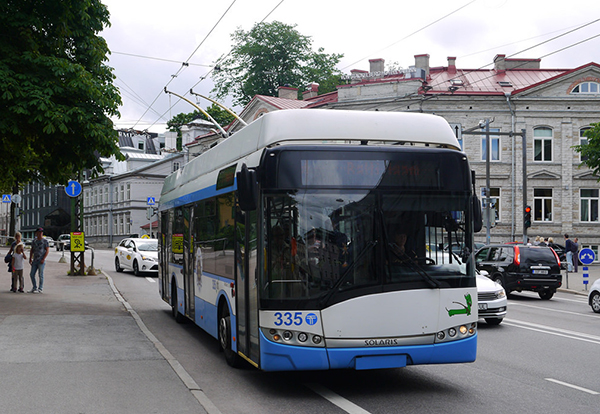
Country Cousin: The smallness of population that has allowed Estonia to steal the march on Aotearoa towards becoming a democratic-climate-action role model, commends it as a constructive mentor for the once-were-ecowarriors. It is a measure of how craven-to-neoliberalism a country has become when its capital city could no longer support trolleybuses, thanks to its privatised electrical grid becoming so neglected that Wellington City Council found it much cheaper to resort to diesel-powered buses. Estonia, having successfully trialled it in Tallinn, is now rolling out free public transport to the entire country, in part to permit poorer people to commute to new jobs. image Ruairidh MacVeigh
Reprehensibly, before becoming a democratic-climate-action role model, Aotearoa must first play catch-up. Prime Minister Jacinda Ardern’s role model Helen Clark onz ssi pc wasted nine years, her parting shot being a worse-than-useless emissions-trading scheme. In the 18 years that Labour, followed by National, fiddled, Estonia has left New Zealand in the dust, in respect to both democracy and climate action. At it since 2005, in last year’s local government elections—for which the age of enfranchisement had been dropped to 16—one third of Estonians voted online. On the climate action front, the country has just committed to making public transport free, after trialling it in its capital, Tallinn. Not that New Zealand should give up its electronic fare payment card system, because, apart from the very useful revenue, it provides the perfect tool to incentivise off-peak travel. Further, it is perverse to incentivise physical travel over activities readily performed via fibre-optic cable. Regardless, Aotearoa should offer to twin with Estonia, and to make it the first online twinning, 100% free of the customarily attendant long-haul junkets.
With its unique trove of last-and-first stories to tell, Aotearoa is in a powerful position to get the ear of the global audience. Beginning from the beginning, it was the last substantial, landmass—continental Zealandia—to be created geologically, before being comprehensively drowned. It was the last substantial landmass to be discovered by Homo sapiens sapiens—specifically, those voyagers extraordinaire, the Polynesians. Aotearoa was then the last substantial landmass to be explored by the old world—with the insight, guidance and flair of the deifiablealthough deifiable appears in print, it doesn’t in dictionaries, but deserves to, on the strength of Dame Anne alone Dame Anne Salmond, the three voyages of Captain James Cook are a blockbusting trilogy right there. Then, shortly after becoming the first country to provide indigenous enfranchisement—with an innovative, dedicated electoral roll—the world’s first full democracy.
That would keep a new New Zealand national film corporation in clover while the country lifted its game sufficiently for the story to become: world’s first certified climate-action role model; world’s most advanced democracy. And a world awash with fake news awaits, desperate for fact-far-stranger-than-fiction stories.
Aotearoa mobilising, with new zeal for democratic, meaningful climate action.
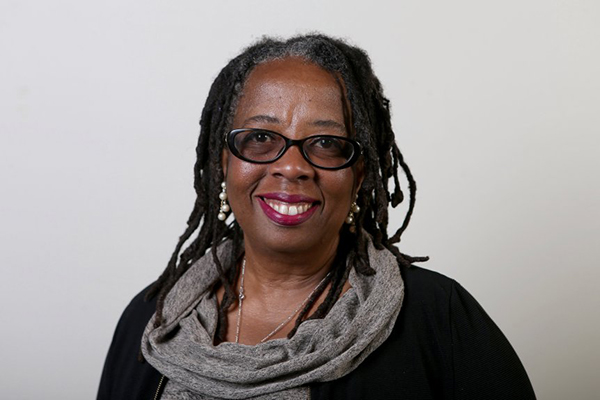
Cannot Fool all the People all the Time: In contrast to New Zealand’s tepid, proposed zero-carbon by 2050 target, Berkeley, California plans to be sub-zero-carbon by 2030, thanks in part to first-time councillor Cheryl Davila, and part to a progressive population that gave only 3.2% of its popular vote to liar-in-chief Donald Trump. Davila’s election—her’s, the first fresh face on the council in 21 years—was also a triumph for preference voting, in the three-horse race. image Anda Chu | Bay Area News Group
Update Illustrating the odds against a major country reaching climate-action-role-model status ahead of li’l ol’ Aotearoa, the Berkeley City Council has just adopted a carbon-sink-by-2030 goal that even mirrors the Mahurangi Magazine’s generally controversial contention that addressing population is crucial to meaningful climate action. These bold plans are a starkly refreshing contrast to the bought-and-paid-for climate inaction of United States Congress, and reflect that Berkeley, California is an overwhelmingly Democratic city—Berkelians voted 90.4% to 3.2% against Donald Trump, when across the United States the popular vote was only 48.2% to 46.1% against him.
Update update Further illustrating the importance of preference voting, for the first time a black American woman, London Breed, has won the San Francisco mayoralty. After holding a nearly 10% lead in the first preferences, Breed narrowly emerged as the most preferred candidate despite her two main rivals colluding to urge their supporters deny her their second preferences. Unfortunately for San Franciscans, their preference-counting system appears to less sophisticated than that which, in a world-first, was first computerised in Aotearoa—the counting continues 12 days onas at 17 June 2018, although Breed’s main rival, who had hoped to become San Francisco’s first openly gay mayor, conceded after the first 8 days. Breed is a major champion of the city’s public transport system, for example carrying the legislation authorising the purchase of 33 articulated low-floor trolleybuses, and helping launch a raft of transit prioritisation measures including intersections that, rather than holding up buses, allow them to proceed to stops immediately beyond them.
